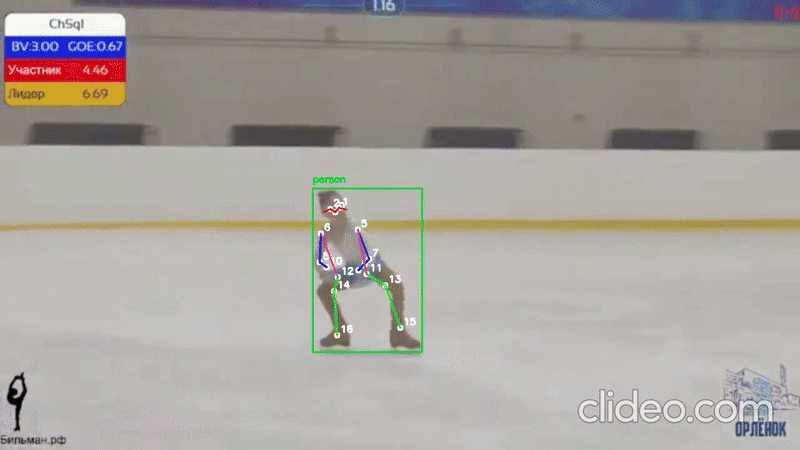Researchers from HSE University in Perm Teach AI to Analyse Figure Skating

Researchers from HSE University in Perm have developed NeuroSkate, a neural network that identifies the movements of skaters on video and determines the correctness of the elements performed. The algorithm has already demonstrated success with the basic elements, and further development of the model will improve its accuracy in identifying complex jumps.
Figure skating is a technically challenging sport in which not only speed and strength are important, but so is precision of movement. Coaches rely on their eyes and experience, but objective data can provide more information on which elements work better, which require improvement, and how technique changes over time. This is especially valuable in children's sports, where groups can have as many as 15 people and it is difficult for coaches to monitor each athlete at the same time.
The team of the NeuroSkate project, which includes Anna Provorova, Daria Semenova, Lyudmila Gergert, Sofya Kulikova, and Irina Polyakova, decided to test how artificial intelligence would cope with analysing the movements of figure skaters. The researchers selected six movements that are easy to identify by an athlete's posture: Biellmann, spin, boat, and several basic single jumps—flip, Rittberger, and Lutz. The main idea was that the neural network could automatically find the skater in the video, track their movements, and mark the performed element.
‘It sounds simple, but in practice it’s not an easy task. Large databases are required to train algorithms, and very few of them are open source. Research analyses adult athletes, but no one has collected videos of young figure skaters with marked movements so far,’ says Anna Provorova, Junior Research Fellow at the HSE Centre for Cognitive Neuroscience in Perm.
The project was implemented in collaboration with the Orlyonok Sports School of the Olympic Reserve in Perm, which provided data for training the neural network.
‘While the skaters were on their summer break, we used competition recordings and publicly available videos. Later, we managed to take our own training footage, but only on a phone, without professional equipment, which affected the image quality and marking accuracy,’ says Sofya Kulikova, Director of the HSE Centre for Cognitive Neuroscience in Perm.
Motion recognition includes several stages. First, the video is divided into frames, each of which highlights key points on the skater's body. Then a sequence of 60 frames with marked dots is transmitted to a neural network that analyses the athlete's movements.

First, the model was tested in binary classification: it was offered pairs of movements to distinguish, such as a Rittberger and a boat, without adding other elements. In this format, the system worked stably, showing an accuracy of 72%. But as soon as the task became more complicated and more elements were added, the system started to make mistakes. The researchers continued to mark up new videos and further train the model, making it easier to recognise athletes in the video.

The developers have also created a web application that allows users to upload training videos and analyse the statistics of a particular athlete. This could become a tool that helps coaches monitor student progress without having to review hours of recordings.
‘We hope to keep working on the project, as we have ideas on how to improve the algorithm: the most important thing is to collect a large and high-quality database of athletes' videos. There is also an understanding of how to improve the motion recognition process, for example, using graph neural networks. This is a very promising area. One of these models (HD-GCN) showed impressive results, which were presented at the International Conference on Computer Vision in 2023. However, it has not yet been possible to launch it on real project data,’ says Anna Provorova.
The study was implemented as part of the Priority 2030 programme.
See also:
Larger Groups of Students Use AI More Effectively in Learning
Researchers at the Institute of Education and the Faculty of Economic Sciences at HSE University have studied what factors determine the success of student group projects when they are completed with the help of artificial intelligence (AI). Their findings suggest that, in addition to the knowledge level of the team members, the size of the group also plays a significant role—the larger it is, the more efficient the process becomes. The study was published in Innovations in Education and Teaching International.
New Models for Studying Diseases: From Petri Dishes to Organs-on-a-Chip
Biologists from HSE University, in collaboration with researchers from the Kulakov National Medical Research Centre for Obstetrics, Gynecology, and Perinatology, have used advanced microfluidic technologies to study preeclampsia—one of the most dangerous pregnancy complications, posing serious risks to the life and health of both mother and child. In a paper published in BioChip Journal, the researchers review modern cellular models—including advanced placenta-on-a-chip technologies—that offer deeper insights into the mechanisms of the disorder and support the development of effective treatments.
Using Two Cryptocurrencies Enhances Volatility Forecasting
Researchers from the HSE Faculty of Economic Sciences have found that Bitcoin price volatility can be effectively predicted using Ethereum, the second-most popular cryptocurrency. Incorporating Ethereum into a predictive model reduces the forecast error to 23%, outperforming neural networks and other complex algorithms. The article has been published in Applied Econometrics.
Administrative Staff Are Crucial to University Efficiency—But Only in Teaching-Oriented Institutions
An international team of researchers, including scholars from HSE University, has analysed how the number of non-academic staff affects a university’s performance. The study found that the outcome depends on the institution’s profile: in research universities, the share of administrative and support staff has no effect on efficiency, whereas in teaching-oriented universities, there is a positive correlation. The findings have been published in Applied Economics.
Physicists at HSE University Reveal How Vortices Behave in Two-Dimensional Turbulence
Researchers from the Landau Institute for Theoretical Physics of the Russian Academy of Sciences and the HSE University's Faculty of Physics have discovered how external forces affect the behaviour of turbulent flows. The scientists showed that even a small external torque can stabilise the system and extend the lifetime of large vortices. These findings may improve the accuracy of models of atmospheric and oceanic circulation. The paper has been published in Physics of Fluids.
Solvent Instead of Toxic Reagents: Chemists Develop Environmentally Friendly Method for Synthesising Aniline Derivatives
An international team of researchers, including chemists from HSE University and the A.N. Nesmeyanov Institute of Organoelement Compounds of the Russian Academy of Sciences (INEOS RAS), has developed a new method for synthesising aniline derivatives—compounds widely used in the production of medicines, dyes, and electronic materials. Instead of relying on toxic and expensive reagents, they proposed using tetrahydrofuran, which can be derived from renewable raw materials. The reaction was carried out in the presence of readily available cobalt salts and syngas. This approach reduces hazardous waste and simplifies the production process, making it more environmentally friendly. The study has been published in ChemSusChem.
How Colour Affects Pricing: Why Art Collectors Pay More for Blue
Economists from HSE University, St Petersburg State University, and the University of Florida have found which colours in abstract paintings increase their market value. An analysis of thousands of canvases sold at auctions revealed that buyers place a higher value on blue and favour bright, saturated palettes, while showing less appreciation for traditional colour schemes. The article has been published in Information Systems Frontiers.
New Method for Describing Graphene Simplifies Analysis of Nanomaterials
An international team, including scientists from HSE University, has proposed a new mathematical method to analyse the structure of graphene. The scientists demonstrated that the characteristics of a graphene lattice can be represented using a three-step random walk model of a particle. This approach allows the lattice to be described more quickly and without cumbersome calculations. The study has been published in Journal of Physics A: Mathematical and Theoretical.
Scientists Have Modelled Supercapacitor Operation at Molecular and Ionic Level
HSE scientists used supercomputer simulations to study the behaviour of ions and water molecules inside the nanopores of a supercapacitor. The results showed that even a very small amount of water alters the charge distribution inside the nanopores and influences the device’s energy storage capacity. This approach makes it possible to predict how supercapacitors behave under different electrolyte compositions and humidity conditions. The paper has been published in Electrochimica Acta. The study was supported by a grant from the Russian Science Foundation (RSF).
Designing an Accurate Reading Skills Test: Why Parallel Texts are Important in Dyslexia Diagnosis
Researchers from the HSE Centre for Language and Brain have developed a tool for accurately assessing reading skills in adults with reading impairments. It can be used, for instance, before and after sessions with a language therapist. The tool includes two texts that differ in content but are equal in complexity: participants were observed to read them at the same speed, make a similar number of errors, and understand the content to the same degree. Such parallel texts will enable more accurate diagnosis of dyslexia and better monitoring of the effectiveness of interventions aimed at addressing it. The paper has been published in Educational Studies.




